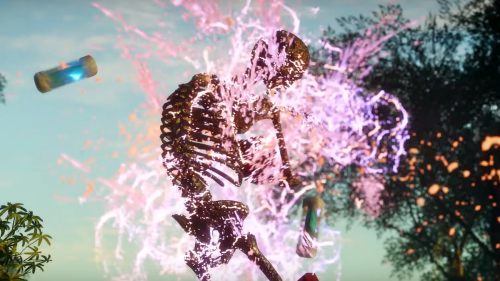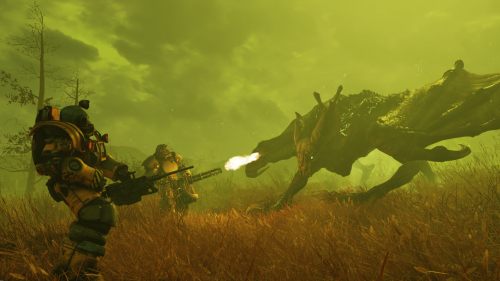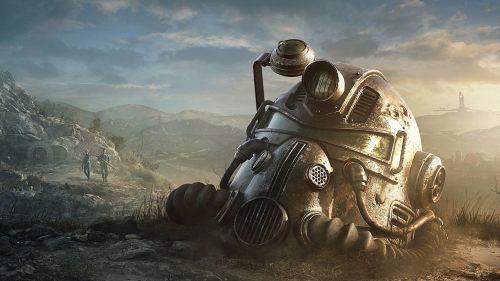The FALLOUT 76 Diaries, Part Four: Role-Playing Solo
I spent hours in Fallout 76 trying to kill Evan. Not BMD’s Evan, though he probably deserves it, despite his claim of being the guy who saves everyone. Evan is an in-game character, and like most of the human characters in Fallout 76 he’s dead. Or nearly dead, anyway — the poor guy has become a ghoul. It’s my job to make him really dead. And I can’t do it, because the game won’t let me.
“Kill Evan” is an objective part-way the main mission quest that begins the moment any character steps out of Vault 76 and into the post-apocalyptic wasteland of Appalachia. Once you get to the proper point in the game, finding Evan is easy. Killing him is harder, because someone else has beaten me to it. But that’s not a story point; it’s a bug.
As an always-on multiplayer game, Fallout 76 has some big problems in the intersection between that persistent, ever-moving world, set in a post-apocalyptic West Virginian “Appalachia,” and the individual stories needed to create an experience for each player. Fallout began as a turn-based RPG, with options for player actions in combat strictly dictated by points. It has slowly mutated, like a Vault dweller exposed to radiation, into a genre hybrid, a shooter with a surprisingly deep crafting system and some vague suggestion of those early RPG origins.
Players now share an instanced map with up to 23 other players on a server. That means that theoretically, two dozen people could try to kill Evan at the same time — but they would all be seeing the same single Evan. Inevitably, what happens is that someone on the map kills Evan, then everyone who shows up later finds only a corpse with an objective marker on it, and no way to advance the story until Evan respawns after some time has passed. Will Evan respawn right in front of me if I waited around long enough? I don’t know — but I do know that backing out of the map and re-entering, which likely drops you onto a new server where Evan may still be alive, is the best way to complete the quest right now.
Nothing breaks the immersion of a role-playing game like having to quit and restart just to move a story forward. At this point, I’m not sure Fallout 76 cares about being a role-playing game. After 25 hours I’m still not sure what this game wants to be.
I do know how I’m playing the game, however, and despite its many problems I keep going back into the Appalachian wasteland. Playing with a group of friends has been entertaining, but with the BMD group scattered through different time zones I’ve spent a lot of time in Fallout 76 alone. I have no interest in speaking to random other players — I’m not going to wear a chat headset just on the off chance I run into someone — and the game has been fairly welcoming to me as a solo player.
Unlike some of my peers here at BMD, I’m not terribly bothered that the story is stuck in the past. Roaming through this wasteland, I feel like an anthropologist — but one who might also be the Will Forte character in the first episodes of Last Man on Earth. It’s obvious that this game is not just a continuation of the prior Fallout style, despite the fact that a cursory glance suggests it is basically Fallout 4.5 with mutiplayer.
Bizarre dioramas and pockets of odd behavior are still hidden throughout the wasteland. A golf bag full of different-colored garden gnomes is half-buried way down at the southern fringe of the map. I played music on the rooftops of a city in which ghouls and berserk robots battled, and watched, still playing a steel guitar, as a couple Vertibirds — basically big military planes — circled overhead, engaged in a firefight with the robots. Evidence is everywhere of the different ways people chose to spend their last moments before the bombs dropped. (Though it seems like few people in Appalachia spent their last minutes having sex; there should be a lot more skeleton couples in bed. Maybe people just ended their lives sexually solo.)
The greatest loss in Fallout 76, from my perspective, isn’t the human NPCs which were previously a core aspect of in-game storytelling. It’s the lack of variability. Storylines are little more than fetch quests, with such specific objectives that there’s little leeway to achieve success with unconventional means. Now, you can blow things up in various ways — through stealth backstabbing or explosives or regular old guns — but most of the story and quest beats come down to finding an object, moving it somewhere else, and perhaps fixing a thing, most of which is done by pressing X. (I’m playing on PS4; your specific button press may vary.)
So I’ve replaced that formalized variability with my own. My Fallout 76 is role-playing as a single person trying to survive a harsh environment. I like scrounging for parts and food. The need to constantly eat and drink is strangely compelling, as I’m driven to search for the best stuff to consume, which typically means rooting out new recipes and ingredients — and that’s a lot more active storytelling on a personal level than most of the game’s formal quests. (Scott joked about me making a crumble. I maintain that my time was well-spent.) In Oblivion and Skyrim, two fantasy games in the Elder Scrolls series by Fallout 76 developer Bethesda, I played probably close to 200 hours of each title while doing very little of the main stories. I never came close to “completing” either game, but had a great time wandering around finding strange little stuff to do. Some hardcore fans have complained that Fallout 76 is the latest effort by Bethesda to make the Fallout and Elder Scrolls series into the same thing. Frankly, I don’t really care if that’s the case.
The crafting system, which allows players to create everything from guns and ammo to armor from the ground up, is so robust that I’ve only begun to scratch the surface. Games like Minecraft never caught my interest, and the building mechanics in Fortnite actively pushed me away from that game. Here, however, I’ve already build and found satisfaction defending and maintaining a small home base, and can see expanding those efforts into gameplay that develops my “solo weirdo in the wasteland” approach to the game. It helps that Fallout 76 lets players fast-travel to their camp for free. (Other destinations cost Caps, which are a relatively rare resource in this game.) Being able to blueprint a camp design, moving it across Appalachia as I explore the map, has made solo play possible. There’s always a solid place to retreat to.
Some design decisions still seem… strange. SPECIAL, the character-development system which allocates points to personal attributes like strength and agility, is implemented very differently than in the past, and the ramifications are big. Perception, for example, once helped players see additional dialogue options or resolution options for a given scenario. Players with high Charisma could talk themselves out of a fight, or into a reward.
In Fallout 76, Charisma affects groups by allowing players with high Charisma to share perks with other players on a team — it’s basically the stat for those who want to play as a medic. If you’re playing solo, nothing in the first 25 hours of the game suggests there’s much reason to drop points into Charisma at all. That means that a whole aspect of the character creation tree is stunted for those who choose to go it alone. Combinations of stats like Perception, Intelligence, and Luck once helped players pick locks and hack computer terminals. Those now require specific Perk cards. Don’t have a Level 2 lockpick Perk card? You can’t even try and fail to pick a higher-level lock. That inches the role-playing door closer to shut.
Earlier I said I wasn’t trying to kill BMD’s Evan, but that wasn’t entirely true. He made a mistake somewhere along the line (honestly, he made a lot of mistakes) and was tagged “Wanted.” That's the in-game system for dealing with griefers, and it's actually pretty ingenious. Kill a player who didn’t want to engage in PvP — basically someone who doesn’t shoot back — and you’re marked red, with a Wanted badge, on the world map. Any other player on the server can see that badge, and either avoid the Wanted player, or move in to kill them and collect a bounty. (The bounty comes out of the Wanted player’s own stash of currency; a nice touch.)
Because I’m most interested in playing solo, the idea of dealing with unwanted PvP was one of the most unappealing things about Fallout 76. But the map is huge and I have yet to see more than two Wanted players at the same time. There’s always the chance that you might be interrupted by a griefer in the middle of a timed mission, but occasional bursts of violence like that fold pretty easily into my in-game roleplaying worldview. (Those timed missions, called Events, are also often well-marked on the map and my solo gameplay style has been to avoid them.)
This game is still buggy and sometimes obscure. The first massive patch smoothed out a lot of problems, on the PS4 at least. Bugs like the Kill Evan problem persist, however. I can’t quite figure out the respawn system, which seems to allow me to respawn near my place of death after one kill, but then won’t let me re-enter the game anywhere but Vault 76 the next time I die.
And yet the core appeal, in place since Bethesda took over with Fallout 3, remains. The world itself is compelling. I’m drawn back in — and while I was initially just as frustrated with Fallout 76 as many others, I’ve found my own rhythm with the game. With an overarching story of limited appeal I don’t know how long I’ll stick around, but my Oblivion and Skyrim experience suggests it might be a while.



